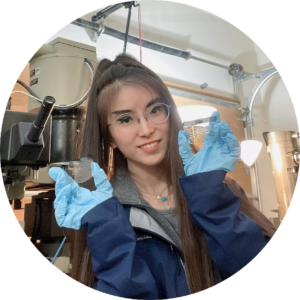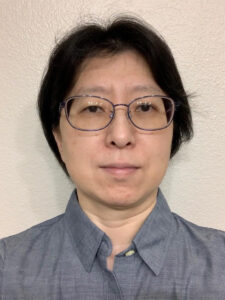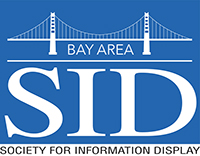Archives 2022
December 14, 2022
Developing Next-Generation Quantum Dots for Next-Generation Displays
Dr. Ilan Jens-La Plante, Senior Staff Scientist at Nanosys
Presentation Abstract
Dr. Ilan Jens-La Plante, Senior Staff Scientist at Nanosys
 Dr. Ilan Jen-La Plante is a Senior Staff Scientist at Nanosys where she leads photoluminescent materials development for future display technologies. As a member of the R&D team since 2016, she has contributed to many of Nanosys’ Quantum Dot (QD) technologies including the development of bright and narrow heavy-metal free QDs for QD enhancement film technology, highly absorptive QDs for QD color conversion, and QD encapsulation methods to enable operation without external gas barrier films. Most recently her work has focused on understanding and improving QD photostability under a wide range of environmental and operating stressors including humid/aerobic conditions and high excitation flux to enable a display roadmap capable of reaching 1 million nits of brightness.
Dr. Ilan Jen-La Plante is a Senior Staff Scientist at Nanosys where she leads photoluminescent materials development for future display technologies. As a member of the R&D team since 2016, she has contributed to many of Nanosys’ Quantum Dot (QD) technologies including the development of bright and narrow heavy-metal free QDs for QD enhancement film technology, highly absorptive QDs for QD color conversion, and QD encapsulation methods to enable operation without external gas barrier films. Most recently her work has focused on understanding and improving QD photostability under a wide range of environmental and operating stressors including humid/aerobic conditions and high excitation flux to enable a display roadmap capable of reaching 1 million nits of brightness.
November 9, 2022
An Andvanced Materials Platform to Reshape and Reimagine Electronics
Dr. Ajay Virkar, C3Nano Co-Founder, Chief Technology Officer, Board Member
Presentation Abstract
C3Nano’s platform technology is being utilized to empower a wide variety of electronics ranging from smartphones and switchable windows to biomedical devices and transparent heaters for automotive applications. C3Nano will discuss this platform consisting of the highest quality and scale Silver Nanowires (AgNWs), Noble metal-coated Ultra-Nanowires™ with unprecedented stability and reliability, and its best-in-class ActiveGrid™ inks and coatings. These conductive coatings have outstanding flexibility and mechanical properties and are compatible with a broad array of flexible, stretchable, and formable substrates. C3Nano will also describe a recent technology breakthrough wherein its new ActiveGrid™ LT ink series can be cured at room temperature incredibly quickly (~25 C for ~ 1 min) to impart electrical conductivity on a variety of low Tg, soft, bio-compatible, and low-cost substrates targeting novel applications in displays, life-sciences, smart-packaging, and anti-statics. We will also describe how our NWs (and Ultra-NWs) are ideal materials for conductive fillers - achieving excellent conductivities at extremely low volume fractions (loadings) unlocking broad new applications and potentials in the multibillion-dollar conductive composites, adhesives and 3D-printing markets. Finally, C3Nano will discuss its some of its current commercial traction and how its technology platform is being used to generate smart surfaces and new functionalities in several of the aforementioned sectors. The ability to add electrical conductivity by depositing ActiveGrid ink as ultrathin layers on substrates, or by addition of low volume fractions of Nanowires and Ultra-Nanowires into composites, can liberate the imagination to enable new transformative displays, devices, and HMI experiences.
Dr. Ajay Virkar, C3Nano Co-Founder, Chief Technology Officer, Board Member
 Ajay oversees C3Nano’s research and new technology development, intellectual property, and manages several commercial and technical partnerships. He has helped C3Nano raise more than $75 Million in strategic and venture capital. Ajay has more than one hundred patents (issued or pending) and has co-authored eleven technical publications in peer-reviewed journals. He completed his BS in Chemical & Biomolecular Engineering (with honors) at the University of Illinois (UIUC) and his PhD in Chemical Engineering at Stanford University. He is an advisor for the Department of Energy’s Made in America Solar Initiative and an associate producer for the documentary film Infinite Potential about the life and times of physicist and philosopher David Bohm.
Ajay oversees C3Nano’s research and new technology development, intellectual property, and manages several commercial and technical partnerships. He has helped C3Nano raise more than $75 Million in strategic and venture capital. Ajay has more than one hundred patents (issued or pending) and has co-authored eleven technical publications in peer-reviewed journals. He completed his BS in Chemical & Biomolecular Engineering (with honors) at the University of Illinois (UIUC) and his PhD in Chemical Engineering at Stanford University. He is an advisor for the Department of Energy’s Made in America Solar Initiative and an associate producer for the documentary film Infinite Potential about the life and times of physicist and philosopher David Bohm.
October 26, 2022
NanoLEDs for AR/VR Microdisplays
Dr. Seth Coe-Sullivan, President, CEO & co-founder of NS Nanotech, Inc.
Presentation Abstract
Dr. Seth Coe-Sullivan will describe NS Nanotech’s new methods for growing nanoLEDs and resulting structures that demonstrate a viable path to overcome current efficiency limits of LEDs for microdisplays and AR/VR displays. The company’s patented technology enables fabrication of components that are smaller and draw less power than current LED solutions, while emitting brighter, more saturated, more stable, and more directional light. NS Nanotech previously announced breakthroughs in green LED performance, with laboratory fabrication of green GaN nanoLEDs that set records for brightness, efficiency, color saturation, directionality, and power consumption, including EQE greater than 11% directly on the wafer. NS Nanotech recently developed red-emitting N-polar InGaN/GaN nanowire heterostructures demonstrating the smallest size red-emitting LEDs ever. The device surface area is nearly three orders of magnitude smaller than some of the previously reported InGaN quantum well red micro-LEDs, and it set a record for efficiency of a submicron-scale red LED, with EQE greater than 1% directly on the wafer. In his talk, Dr. Coe-Sullivan will provide updates on the company’s latest nanoLED performance milestones and discuss the possibilities and potential timelines for delivery of commercial RGB nanoLEDs for AR/VR microdisplays.
Dr. Seth Coe-Sullivan, CEO & Co-Founder, NS Nanotech, Inc.
 Seth Coe-Sullivan is co-founder, board member, Chief Executive Officer, and President of NS Nanotech, Inc., a spin-out from the University of Michigan and McGill University with technology developed by Professor Zetian Mi. In January 2020, NS Nanotech was developing future nanoLED products for the next generation of TVs, phones, and computer displays. But when Covid-19 arrived, Dr. Coe-Sullivan knew the company’s extensive experience with nitride semiconductors could help fight the virus. He pivoted the company’s R&D team to development of the NS Nanotech ShortWaveLightTM Emitter, the world's first solid-state semiconductor device capable of emitting pathogen-neutralizing far-UVC light.
Seth Coe-Sullivan is co-founder, board member, Chief Executive Officer, and President of NS Nanotech, Inc., a spin-out from the University of Michigan and McGill University with technology developed by Professor Zetian Mi. In January 2020, NS Nanotech was developing future nanoLED products for the next generation of TVs, phones, and computer displays. But when Covid-19 arrived, Dr. Coe-Sullivan knew the company’s extensive experience with nitride semiconductors could help fight the virus. He pivoted the company’s R&D team to development of the NS Nanotech ShortWaveLightTM Emitter, the world's first solid-state semiconductor device capable of emitting pathogen-neutralizing far-UVC light.
NS Nanotech has exclusive rights to a patent portfolio based on more than a decade of groundbreaking work on nanoLEDs by Prof. Mi at the University of Michigan and McGill. Beyond today’s semiconductor-based far-UVC emitters, the company is developing next-generation nanoscale Gallium-Nitride (GaN) nanoLEDs for UVC disinfection applications, for large displays, and for microdisplays required for augmented reality and virtual reality (AR/VR) applications.
Dr. Coe-Sullivan has a distinguished background in nanotechnology-based solid-state product development. Until 2019 he was Chief Technology Officer of Luminit LLC, where he led R&D and growth through development and introduction of new products. While there he launched the world’s first volume holographic combiner product for augmented reality displays, procuring first customers, completing development, and setting up manufacturing. Before joining Luminit, he was co-founder, board member, and Chief Technology Officer of QD Vision, which was acquired by Samsung. QD Vision’s quantum dot technology is now integrated into Samsung’s QLED televisions.
Dr. Coe-Sullivan received his Ph.D. in Electrical Engineering from the Massachusetts Institute of Technology in 2005, and his Sc.B from Brown University in 1999. He has more than 50 papers, patents, and patents-pending in the fields of organic light emitting devices, quantum dots, displays, and environmental health and safety. He has received many industry awards including Technology Review Magazine’s TR35 Award, BusinessWeek’s top young entrepreneurs, Wall Street Journal’s Innovation Award, the SEMI Award for North America, and the Presidential Green Chemistry Award. Most recently he received the Society for Information Display’s Peter Brody Award for his pioneering work bringing quantum dot technologies to market.
September 29 2022
An Evening with Meta Materials: Automated Lens Casting Embedding Multi-functional Metasurfaces for AR displays
Dr. Jonathan Waldern, CTO at Meta Materials
Presentation Abstract
Dr. Jonathan Waldern, CTO at Meta Materials
 Dr. Waldern brings 25 years of experience in commercialization of holographic and lithographic/nanomaterials for photonic applications. He has pioneered the development of a wide range of displays, scanners, and active integrated optical components for LED and laser illumination. He is an inventor of over 170 patents to date, principally in XR (Extended Reality) waveguide displays, holographic materials and manufacturing processes. Dr. Waldern joins META from DigiLens, Inc. a company he founded in 2004 and held various leadership positions, including CTO. He is the recipient of three National Business Awards and amongst several product accolades, won SID “Best New Display” for motorcycle HUD AR glasses whilst partnering BMW. He started his career in XR founding W Industries in 1988, later renamed Virtuality Inc, which pioneered the world’s first production VR (virtual reality) workstations and networked VR entertainment simulators, developing new ways to interact with computers.
Dr. Waldern brings 25 years of experience in commercialization of holographic and lithographic/nanomaterials for photonic applications. He has pioneered the development of a wide range of displays, scanners, and active integrated optical components for LED and laser illumination. He is an inventor of over 170 patents to date, principally in XR (Extended Reality) waveguide displays, holographic materials and manufacturing processes. Dr. Waldern joins META from DigiLens, Inc. a company he founded in 2004 and held various leadership positions, including CTO. He is the recipient of three National Business Awards and amongst several product accolades, won SID “Best New Display” for motorcycle HUD AR glasses whilst partnering BMW. He started his career in XR founding W Industries in 1988, later renamed Virtuality Inc, which pioneered the world’s first production VR (virtual reality) workstations and networked VR entertainment simulators, developing new ways to interact with computers.
August 26 2022
BASID Annual Dinner, August 26, 2022 - The Future is Now
Dr. & Mrs. Future
The Bay Area Chapter of SID invites you and your guest to the BASID 2022 Annual Dinner

Join your local display industry colleagues for a summer evening full of delicious food, great company, a beautiful location, and a moving keynote address!
Sponsored by Silvaco and Applied Materials.
For this year's presentation, our keynote speakers, Allan & Sun Lundell, will conduct a live audience version of their popular radio program, "The Dr. Mrs. Future Show." Broadcasting on talk radio station KSCO every Tuesday afternoon primetime for the last 12 years, Allan & Sun, as Dr.Mrs. Future, discuss all things future to their Monterey Bay/San Jose audience, on AM/FM and streaming on the web. The future includes science, technology, the internet and consciousness research. They hold that we are entering a true renaissance that will make the one that occurred during the Middle Ages seem like child's play, and that our future is bright. The big issues of today, such as a politically fractured culture and catastrophic climate change, will be resolved as we embrace our larger identities as global humans and take action. As a tech and culture journalist for years in the Bay Area (Byte, Infoworld, DV, Mondo 2K, Wired) Allan Lundell has kept his finger on the pulse of change and is optimistic about what we can achieve next. And as a pioneer of the desktop publishing revolution and veteran of the analog to digital transition of media, Sun, as Mrs Future, is very articulate in helping us more fully grasp the big changes looming on the horizon. The specific topics discussed will be based on what is most in the news at the time of their presentation, for... The Future is Now. www.drfutureshow.com http://ksco.com/shows/39594-the-doctor-future-showLocation:
Coupa Cafe - Stanford Golf Course
198 Juniper Serra Boulevard
Stanford, CA 94305
Pricing:
Guest of SID Members: $50
Sponsors
We'd also like to recognize and thank our generous sponsors, Silvaco & Applied Materials. Their generosity helped us put on this wonderful event for our community and guests.
 About Silvaco, Inc.
About Silvaco, Inc.
Silvaco, Inc. is a leading EDA provider of software tools used for process and device development and for analog/mixed-signal, power IC and memory design. Silvaco delivers a full TCAD-to- sign-off flow for vertical markets including: displays, power electronics, optical devices, radiation and soft error reliability and advanced CMOS process and IP development. For over 30 years, Silvaco has enabled its customers to bring superior products to market with reduced cost and in the shortest time. The company is headquartered in Santa Clara, California and has a global presence with offices located in North America, Europe, Japan and Asia.

About Applied Materials
Our mission is to help customers turn next-generation technologies into profitable new industries. We engineer highly sophisticated manufacturing equipment and processes that are used to build complex devices at extremely high-volumes. In personal electronics, volume production of low power, high performance computer chips and touch panels has made innovations such as the tablet PC not only possible, but also affordable for millions of people around the world.
July 20 2022
Integrated Active Matrix Technologies for MicroLED displays
Ioannis (John) Kymissis, Kenneth Brayer Professor of Electrical Engineering at Columbia University and Chair of the Department of Electrical Engineering
Presentation Abstract
MicroLEDs offer extraordinary performance characteristics and potential in both display and non-display applications. The long lifetime, high achievable luminance, outstanding color points, and high efficiency achievable using microLEDs is well recognized and has led to a number of demonstrations including application in microdisplays, intermediate-format transparent displays, large format chiplet-based mass transfer displays, and non-display applications such as superresolution microscopy.
There are, however, a number of challenges which remain in the microLED space. The first is the need for an active matrix to drive displays of any useful size. A second is the need for electrical and optical isolation of smaller pixels. A third is the need for high throughput approaches to examine and improve yield in devices. In this presentation we will discuss some of the solutions demonstrated at Lumiode and Columbia University to approach these issues. Lumiode has demonstrated the direct integration of a high performance backplane directly on the LED substrate using thin film transistors to provide the addressing, switching, and drive for displays. Lumiode has further demonstrated the use of ion implantation to deactivate the dopants in LED contact layers, permitting additional device isolation (down to 1.5 micron pixel size) without the introduction of etched areas that drive recombination and reduce efficiency. We will also review the use of cathodoluminescence for device analysis, strategies for contact optimization, and the development of smart chiplets, which permit the simultaneous assembly of an LED array and transistor backplane. The combination of these approaches offers a number of new elements potentially across a range of microLED display formats.
Ioannis (John) Kymissis
 Ioannis (John) Kymissis is the Kenneth Brayer Professor of Electrical Engineering at Columbia University and Chair of the Department of Electrical Engineering. He graduated with his SB, M.Eng., and Ph.D. degrees from MIT. His M.Eng. thesis was performed as a co-op at the IBM T.J. Watson Research Lab on organic thin-film transistors, and his Ph.D. was obtained in the Microsystems Technology Lab at MIT, working on field-emission displays. After graduation, he spent three years as a postdoc in MIT's Laboratory for Organic Optics and Electronics, working on a variety of organic electronic devices, and also as a consulting engineer for QD Vision (later acquired by Samsung Electronics). He joined the faculty at Columbia University in electrical engineering in 2006. He is a fellow of the IEEE and SID, and was the general chair for the 2014 Device Research Conference.
Ioannis (John) Kymissis is the Kenneth Brayer Professor of Electrical Engineering at Columbia University and Chair of the Department of Electrical Engineering. He graduated with his SB, M.Eng., and Ph.D. degrees from MIT. His M.Eng. thesis was performed as a co-op at the IBM T.J. Watson Research Lab on organic thin-film transistors, and his Ph.D. was obtained in the Microsystems Technology Lab at MIT, working on field-emission displays. After graduation, he spent three years as a postdoc in MIT's Laboratory for Organic Optics and Electronics, working on a variety of organic electronic devices, and also as a consulting engineer for QD Vision (later acquired by Samsung Electronics). He joined the faculty at Columbia University in electrical engineering in 2006. He is a fellow of the IEEE and SID, and was the general chair for the 2014 Device Research Conference.
June 15 2022
Highlights from Display Week 2022
Sweta Dash, Founder and President at Dash-Insights
Robert J (Bob) O'Brien, Co-Founder, Principal and CFO at DSCC
David Naranjo, Senior Director at DSCC
Presentation Abstract
Every year BASID invites industry experts to give their thoughts and insight on products and technologies that were showcased at Display Week 2022. This year we are pleased to welcome speakers from dash-insights and DSCC to share with us their take on Display Week 2022!
Sweta Dash: Emerging Display Technologies at SID Display Week 2022
Display Week 2022 showcased products based on emerging display technologies such as OLED, QD OLED, MiniLED, MicroLED, NanoLED. This presentation will focus on the market implications of these emerging display technologies on various application markets such as TV, monitor, notebook, tablet, smartphones auto, AR/VR and others.
Robert J (Bob) O'Brien: 2022 Display Week - Industry Update and TV Highlights
This presentation will focus on DSCC's key takeaways for TV display technologies/market trends from the SID/DSSC Business Conference, Exhibits and Symposium.
David Naranjo: 2022 Display Week - Industry Update & Smartphones / IT Displays Highlights
This presentation will focus on DSCC's key takeaways for smartphones and IT display technologies/market trends from the SID/DSSC Business Conference, Exhibits and Symposium.
Sweta Dash, Dash-Insights
 Sweta Dash is the Founder/President of Dash-Insights, a market research consulting firm based in San Jose, California, USA. It provides actionable insights for the Display Industry.
Sweta Dash is the Founder/President of Dash-Insights, a market research consulting firm based in San Jose, California, USA. It provides actionable insights for the Display Industry.
She has over 30 years of experience in the Display Industry market research. Her expertise spans the entire spectrum of Display technologies and application markets. She has authored numerous articles and is a well-known keynote speaker for major global industry events. She is a highly sought-after consultant.
Prior to starting Dash-Insights, Sweta was the Senior Director of Display Research, and Strategy at IHS Technology, and was the head of applied research, consulting and strategy. During her years at IHS and iSuppli, she was exceptionally accurate in forecasting LCD supply, demand, pricing, and technology adoption.
Sweta holds a Bachelor of Arts (Hons.) and a Master of Arts in Economics from the University of Toronto, Canada.
Robert J (Bob) O'Brien, DSCC
 Robert J (Bob) O’Brien is Co-Founder, Principal and CFO of DSCC. Bob has decades of experience turning market and business analysis into strategic insights in the display and electronics industries. At DSCC, Bob takes the lead role in analysis of display materials, including glass and AMOLED materials, and covers developments in TV and other large-screen display applications. He is the principal author of DSCC’s AMOLED Material Report, the Advanced TV Shipment Report, and the Display Glass Report, and Bob contributes regularly to the DSCC Weekly Review.
Robert J (Bob) O’Brien is Co-Founder, Principal and CFO of DSCC. Bob has decades of experience turning market and business analysis into strategic insights in the display and electronics industries. At DSCC, Bob takes the lead role in analysis of display materials, including glass and AMOLED materials, and covers developments in TV and other large-screen display applications. He is the principal author of DSCC’s AMOLED Material Report, the Advanced TV Shipment Report, and the Display Glass Report, and Bob contributes regularly to the DSCC Weekly Review.
Working at Corning from 2005-2016, as Director of Market Intelligence and Strategy for Corning Glass Technologies Bob developed an intelligence infrastructure to inform pricing strategy, product development, marketing communications and customer service strategy. He also developed external communications for investors and customers to realize Corning’s industry leading position.
Bob led the CGT intelligence team in building critical tools for analysis of both short- and long-term dynamics in the LCD industry. In response to Corning’s vulnerability to supply/demand swings, Bob developed an analytical model for predicting glass demand based on the supply/demand dynamics of the LCD value chain. The output of this model is frequently quoted in Corning’s earnings release and other communications. To increase understanding of the long-term dynamics of TV replacement, Bob led the efforts on consumer survey work to understand the replacement cycle of TV. As the cover glass market matured, Bob led the effort to explore and develop the Gorilla glass business in emerging markets.
Prior to Corning, Bob worked in engineering, product marketing, finance, and business intelligence for Philips Display Components and LG.Philips Displays. At Philips, Bob led a multi-division team evaluating potential opportunities in large display technologies, with comparative market and technology analysis of LCD, PDP, CRT, and projection. Bob prepared and executed financial and marketing expertise on the plasma display business for the due diligence process during the 2001 international merger which formed LG.Philips Displays.
Bob holds a BS in Applied and Engineering Physics from Cornell University and an MBA from the University of Michigan Business School. He lives in Ann Arbor, MI with his wife Mattie and three sons.
David Naranjo, DSCC
 David joined DSCC in May 2021 as Senior Director. David has more than 20 years’ experience in the consumer and commercial electronics industry. David’s professional background includes a wide range of responsibilities in product development, product planning, product management, product marketing, data analytics, and executive /operational management. Prior experience includes working in the consumer and commercial electronics industry as Director of Business Line Management at ViewSonic, Director of Product Planning at Samsung Electronics, Director of Connected Products at Kenmore, Director of Product Management at Mitsubishi Digital Electronics and Group Manager at Panasonic.
David joined DSCC in May 2021 as Senior Director. David has more than 20 years’ experience in the consumer and commercial electronics industry. David’s professional background includes a wide range of responsibilities in product development, product planning, product management, product marketing, data analytics, and executive /operational management. Prior experience includes working in the consumer and commercial electronics industry as Director of Business Line Management at ViewSonic, Director of Product Planning at Samsung Electronics, Director of Connected Products at Kenmore, Director of Product Management at Mitsubishi Digital Electronics and Group Manager at Panasonic.
He has served on CTA committees and the Video Board. He has been an invited speaker for technical and marketing presentations on the consumer and commercial markets for SID, CTA, FCC, Infocomm and NCTA conferences.
David enjoys hiking, exercising, running, refereeing soccer games, and giving back to the community. In his spare time, he is a substitute teacher for 6th -12th grade students mentors and tutors college students in Math, Science, Accounting, Finance and Economics.
David has a Bachelor of Electrical Engineering and an MBA in Finance and Marketing.
April 13 2022
Ultra-high Performance AR Glasses Optics, Display, System, and Platform
Kelly Peng, CEO, CTO, Founder, Kura Technologies
Presentation Abstract
Kura is building the best performing augmented reality glasses, global telepresence, and remote collaboration platform. Kura's first product, Kura Gallium, has a 150° field of view, 95% transparency (4x of existing), 8K resolution, high brightness, and a compact form factor. This ultra-high performance is achieved by using a unique architecture with fully customized components, including customized micro-LED displays, ASICs, optics, and software systems. All this innovation was recognized during CES 2022 with Kura Gallium receiving the CES Innovation Award. With both hardware and software, the Kura Gallium is a total platform solution with an SDK available for developers. Kura boasts over 350 companies as paid clients (100% in-bounding) with Fortune 500 and Fortune 100 companies accounting for more than 50 of those. In addition over 100K orders are currently on waitlist.
Kelly Peng
 Kelly Peng is the founder, CEO & CTO of Kura Technologies, a company developing best in class augmented reality glasses. She is an inventor holding 10 patents and has worked on many innovative projects including brain-machine interfaces and flying cars. In 2019, Kelly was received the prestigious Forbes “30 Under 30” in Manufacturing and Industry.
Kelly Peng is the founder, CEO & CTO of Kura Technologies, a company developing best in class augmented reality glasses. She is an inventor holding 10 patents and has worked on many innovative projects including brain-machine interfaces and flying cars. In 2019, Kelly was received the prestigious Forbes “30 Under 30” in Manufacturing and Industry.
At UC Berkeley, Kelly worked on customized frequency-modulated LIDAR with mixed-signal ASICs. She was also a founding engineer of the Berkeley Brain-Machine Interface Group working on customized EEG and MEG sensors. She developed a machine learning algorithm for a brain-computer interface which detected likes/dislikes achieving the world's highest accuracy and was on exhibition at the San Francisco Exploratorium Cognitive Technology Exhibit. Other innovative projects Kelly has worked on include building holographic displays, various customized sensors, and a Raman spectrometer. Kelly studied Electrical Engineering and Computer Science at UC Berkeley and University of Illinois, Urbana-Champaign.
March 9 2022
E Ink Color Technology, Product and Applications
Hui Karen Du, AVP, E Ink Corporation
Presentation Abstract
Have you seen the BMW iX Flow concept car at CES 2022? It is wrapped with E Ink digital paper and displays a transformation in the way surfaces are experienced.
E Ink Holdings Inc. is the worldwide leader of Electrophoretic display technology and products. Since 20 years ago, E Ink has transformed and defined the eReader market, enabling a new multi-billion dollar business. Over the last 10 years, the company has developed revolutionary electrophoretic ink with multi-color pigments that enable displays to show a variety of vivid and vibrant color images besides black and white.
During this presentation, the unique features and advantages of E Ink display technology will be introduced and compared with emissive display (LCD, or LED) technology. Further, E Ink’s color ink design, color generation mechanism, and display film structure will be discussed and the major products and applications in consumer electronics and IOT ranging from retail, home, hospital, transportation, smart packaging and fashion, etc that are enabled by color E Ink will be presented. Finally, the vision of smart surfaces with E Ink technology will be presented, a technology that will transform static spaces into something dynamic, spectacular, personalized, and informative.
Hui Karen Du
 Hui Karen Du is the Associate Vice President at E Ink Corporation and currently leads the research department at Billerica, MA. She joined E Ink California (previously at SiPix Imaging) in 2009. Starting from black and white pigment research, she developed new color pigment chemistry and enabled the first electrophoretic display product with 3-particle and 4-particle ink. She is one of the major inventors and contributors to the E Ink SpectraTM 3000 and Spectra 3100TM platforms, which are showing rapid growth in markets such as IoT (internet of things), Manufacturing, Transportation, Healthcare, and Retail.
Hui Karen Du is the Associate Vice President at E Ink Corporation and currently leads the research department at Billerica, MA. She joined E Ink California (previously at SiPix Imaging) in 2009. Starting from black and white pigment research, she developed new color pigment chemistry and enabled the first electrophoretic display product with 3-particle and 4-particle ink. She is one of the major inventors and contributors to the E Ink SpectraTM 3000 and Spectra 3100TM platforms, which are showing rapid growth in markets such as IoT (internet of things), Manufacturing, Transportation, Healthcare, and Retail.
With strong leadership and project management experience, Karen has successfully led teams to convert complex research concepts into manufacturing ready technologies. She has also been an experienced product development leader and has brought innovative technology into commercial products in areas such as electrophoretic color displays.
Prior to E Ink, Karen was senior scientist at NanoGram Corporation, where she worked on nanoparticle synthesis and surface modification. She developed nanocomposite films for multiple applications including refractive index tuning, anti-reflection coating, and light emitting films. Karen originates from China. She graduated from Jilin University with a Ph.D in Chemistry. She received the Stanford LEAD certificate (corporate innovation) in 2017. With over 25 years of experience in polymer science, nanotechnology and display industry, Karen as 27 publications and more than 40 issued patents.
February 9 2022
Presentation Abstract
Analog sensing is undergoing a digital transformation resulting in a new software-defined sensing technology. While analog sensing techniques have matured and plateaued, breakthrough SigmaDrive™ digital technology enables concurrent drive, sense, communications and power all form the same device pin without time multiplexing. For the first time, a system can now both stimulate and receive sensing data concurrently on the same pin. 100-1000X superior SNR enables new modes of operation previously not possible. Sensitivity provides presence detection or hover touchless interaction. SigmaDrive technology also provides a high performance, high quality streamed 3D view of the entire display surface feeding AI based processing to create new human machine interface opportunities.
Gary Baum
 Gary Baum, SVP, Emerging Technology, SigmaSense, brings over 20 years experience as a veteran system and semiconductor industry sales and marketing executive. Mr. Baum is internationally known for his profitable, rapid-growth sales, marketing and business development initiatives. His industry leadership and expertise include semiconductors, notebook computers, workstations and thermal solutions. He has managed global development and sales organizations on multiple occasions, often helping companies grow out of their formative stages towards successful ongoing concerns. Baum has been instrumental in establishing overseas technology companies from France, Denmark, Japan and Israel within the North American market.
Gary Baum, SVP, Emerging Technology, SigmaSense, brings over 20 years experience as a veteran system and semiconductor industry sales and marketing executive. Mr. Baum is internationally known for his profitable, rapid-growth sales, marketing and business development initiatives. His industry leadership and expertise include semiconductors, notebook computers, workstations and thermal solutions. He has managed global development and sales organizations on multiple occasions, often helping companies grow out of their formative stages towards successful ongoing concerns. Baum has been instrumental in establishing overseas technology companies from France, Denmark, Japan and Israel within the North American market.
As a member of the founding team, Baum shaped S3’s Windows graphics accelerator strategy that drove S3 to its successful IPO. Mr. Baum was the creator and director of AMD’s first SoC product line and also the notebook processor business where he drove revenue from zero to over $300M annualized within a 19 month period. While at Intel, he led the company’s CPU field product planning, and drove design win programs such as the Intel “Crush” campaign which resulted in both the IBM PC design win and standardized of the entire PC industry on the X86 CPU architecture.
January 12 2022
Breaking Glass Barriers to the Verse
David Wyatt, CTO @ PixelDisplay
Presentation Abstract
What are the key goals that augmented (AR) and virtual reality (VR) displays must meet, in order to fulfill the many promises of the many hyped “verse” experiences ? What technological advances could re-create the desired human sense of “presence”, in synthetic realities ?
VR & AR are unique in our industry, in that they have already been the subject for visual storytelling for over 30 years, and yet still seem to remain out of reach and common use. They have the potential to elevate the humble visual interface, to the role of core protagonist, in a fictional interactive universe. And have already attracted the attention, wonderment, speculation and investment, of all the major players in content, software and hardware. Yet, for all the attention and high expectations, this vehicle is still, as yet, far from delivering the desired sense of presence. How might the continuing story of VR & AR development play out? Which classical plot might it follow: “Prometheus the Fire Bringer”, “The Labors of Hercules”, “The Apple of Discord”, or the opening of “Pandora’s Box?
This talk will identify some of the key requirements, issues, milestones, and innovations, that have-shaped and will-shape, the reality-visualization industry. And elaborate on the technical challenges and new opportunities, as well as some key innovation paths, potentially solving the lingering issues to make interactive synthetic reality successfully prolific.
David Wyatt
 David Wyatt is the CTO of PixelDisplay, a company he co-founded in 2015. David is the inventor of PixelDisplay’s VividColor, NoBlue, NanoBright, and SmartPixels technologies that give system developers better visual solutions and leading-edge intelligent MicroLED. David originates from rural Australia, the country where he studied Electrical Engineering in South Brisbane College, and earned a Bachelor’s in Computer Science at University of Queensland, before following his engineer passion for both hardware and software into entrepreneurism. He founded his first startup in Taiwan, learning Mandarin on the fly, before finally coming to the US through an acquisition.
David Wyatt is the CTO of PixelDisplay, a company he co-founded in 2015. David is the inventor of PixelDisplay’s VividColor, NoBlue, NanoBright, and SmartPixels technologies that give system developers better visual solutions and leading-edge intelligent MicroLED. David originates from rural Australia, the country where he studied Electrical Engineering in South Brisbane College, and earned a Bachelor’s in Computer Science at University of Queensland, before following his engineer passion for both hardware and software into entrepreneurism. He founded his first startup in Taiwan, learning Mandarin on the fly, before finally coming to the US through an acquisition.
Prior to founding PixelDisplay, David was a Distinguished Engineer, at NVIDIA for 9yrs, leading technology developments on GPU’s and Tegra, including inventing NVIDIA’s Hybrid Graphics, and G-SYNC technologies. Before NVIDIA, David was a Chief Engineer, and Platform Architect at Intel for 8yrs. He previously held lead engineering roles in early fabless graphics pioneers including Weitek and Chips&Technologies. With over 20 years’ experience in Silicon Valley, David’s many pioneering innovations cover a wide range of disruptive technologies: thinner-lighter-faster portable devices, high-performance compute data-center systems, smarter displays and lighting, nanomaterials and more. David has more than 100 issued US patents, out of over 200 patents filed internationally, across a wide variety of areas. David’s IP has become an integral part of industry standards (including VESA, HDMI, HDCP, PCI, USB and JEDEC), and key features on products including those from Apple, Google, Intel, Microsoft, NVIDIA, Lenovo, Sony, Xiaomi and many more.

